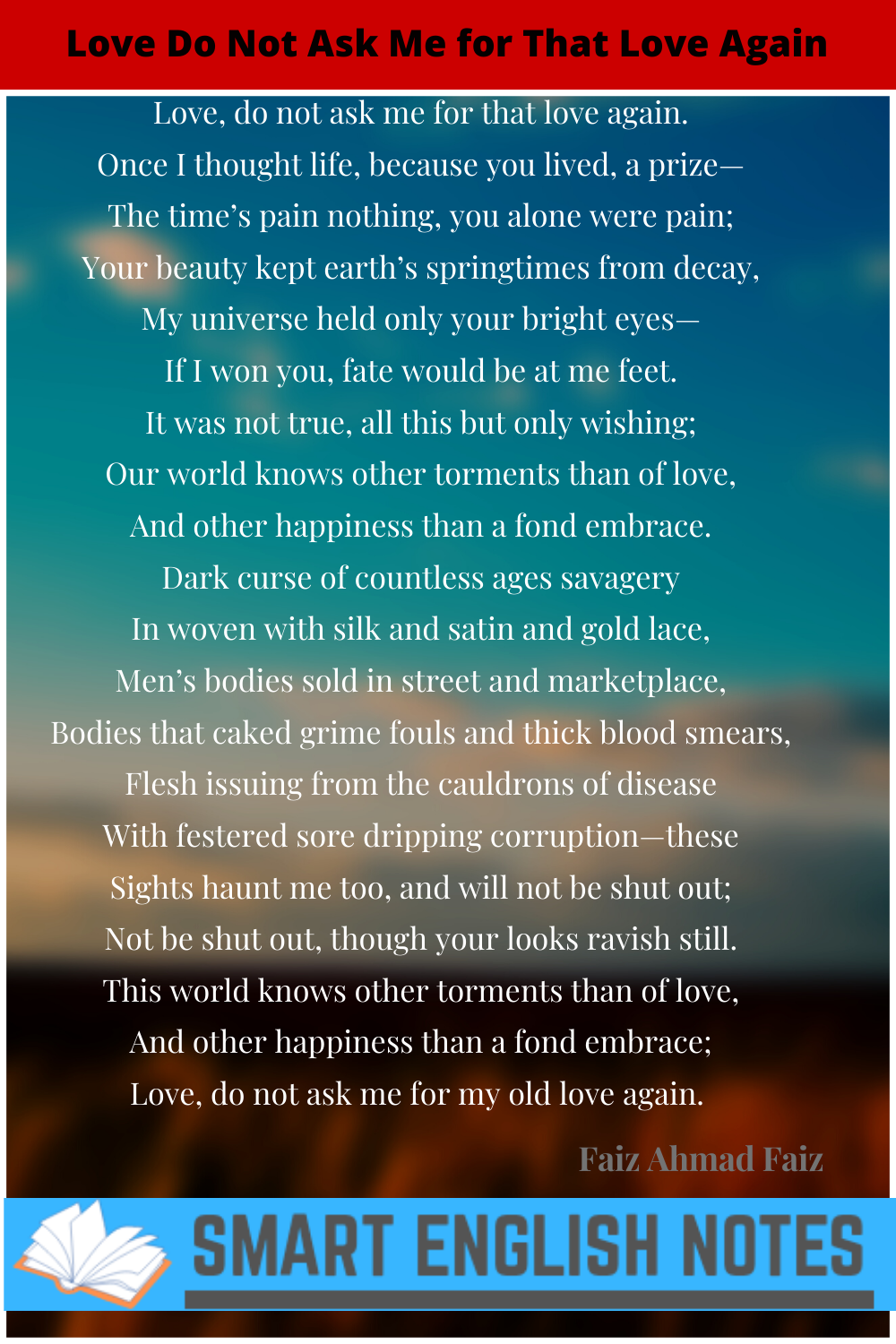Do not Ask of Me, My Love
Introduction
Do Not Ask Me My Love for That Love Again ( Mujh Se Pahli Si Muhabbat Mere Mahboob Na Mang) is a famous Urdu poem written by Faiz Ahmad Faiz. Faiz Ahmad Faiz was an intellectual, revolutionary, and notable Urdu poet. His diverse career earned him a large following. In 1962, the Soviet Union awarded him the Lenin Peace Prize. Faiz was inspired by the Sufi traditions of South Asia.
Text of the Poem

Summary of the Poem
“Do not Ask of Me, My Love” is a poem on changing one’s viewpoint on love. It is a shift from the personal to the universal. The poem begins with the speaker’s appeal to his beloved about her disillusionment with his love. He acknowledges that there was a period in his life when he was struck by love and everything was bright and flourishing. Her beloved’s beauty was everything, and everything else was vanity. Her sorrows were more excruciating. But now the things are different for the poet. He tries to explain to his beloved his current inability to repay the same love he had when they were younger. Then there was her love, which was everything else. Now, he has gained a greater understanding of the world as he has grown older. He believes he must address far larger challenges. There is more to love and more sorrows to comprehend for him. The poem concludes that having a more mature perspective toward love allows one to better understand love and sufferings.
Analysis of the Poem
The poem shows Faiz’s inner conflict between love and patriotism. In this poem, he renounces romantic love for the ‘beloved’ in favour of contemplation of the world’s suffering. The poem is significant because it prompts Faiz to reflect on the sorrow he witnessed around him as a result of his homeland’s freedom struggle. The poem is divided into two halves. The first half begins with a couplet or two-line stanza and is followed by two lengthier stanzas. In this section, the poet addresses his ‘lover.’ He tells his ‘lover’ not to anticipate the type of love he formerly showed her. In the following stanza, he relates and describes how he had perceived ‘life’. Because of his love for his lover, ‘life’ appeared to be quite youthful and flourishing at that time in his life. Since his ‘lover’ was the source of his happiness, he couldn’t bear any form of misery inflicted on him.
The poet asserts that his beloved’s beauty bestowed perpetual youth to the spring. He claims that at the moment, his beloved’s eyes were everything to him and that nothing else could satisfy him. As a result, he had believed that the ‘world’ was his when he was in the company of his beloved.
However, the poet admits in the second half of the stanza that such a thought was merely a creation of his imagination. He now realises that there are other types of agonies in the world besides love’s anguish and that there are other forms of solace besides love’s solace.
In the second half, he explains the ‘agonies’ and various types of solace, in addition to the solace of love, that require his attention. The second part opens with the same couplet, imploring his ‘lover’ not to expect the same type of love that he once felt for her. In the following (longer) stanza, he lists the agonies that demand his attention. They are ‘savagery’ woven in silk and satin and gold lace, which are dark curses of endless years, and human bodies sold in the street and marketplace splattered in blood. They, too, are vying for his undivided attention. He claims that, while her beauty captivates him, there are other types of joy than the bliss of her beauty. He wraps up the second part with the same couplet, this time imploring his lover not to demand the same level of attention as he once did for his beloved. In this poem, the word “beloved” can refer to his “muse,” his country, or his concept of beauty or social reform. This poem is thought to be Faiz’s first attempt at mixing love for the ‘beloved’ with love for humanity, at transforming the sorrow of separation into pain for all those who have suffered under the dark bestial spells of uncounted millennia. In the second verse, he definitely refers to slavery, the slave trade, and prostitution.
Theme of Do Not Ask of Me My Love for That Love Again
This poem is mainly about love that is universal rather than self-centred. The poet used to believe that his beloved was his entire world, but he now realises that this was an illusion. He now understands that there are other hardships and pleasures in the world besides their love. The poet alludes to centuries gone by, which bore the scars of war, slavery, and sickness but are now encased in silk, satin, and brocade shrouds. The speaker is moved by the sufferings and miseries of history.

